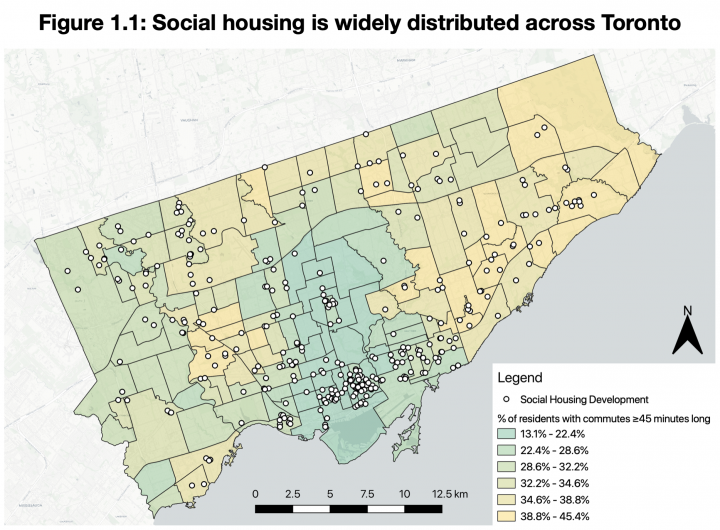Prepared by Gary Gerbrandt • CP 201B/Professor Carolina K. Reid • April 23, 2019
Introduction
I’m interested in Toronto’s social housing buildings and the nature of their inhabitants’ commutes. Media coverage has suggested that lower-income residents of the city face longer commutes than their higher-income counterparts, despite fairly high public transportation usage. Social housing residents are a subset of Toronto’s lower-income residents.
My research question: Do residents of social housing live in neighbourhoods with longer-than-average commute times, despite relatively good proximity to higher-order transit stations?
My hypothesis is that they do—that social housing is distributed near higher-order transit stations, but is concentrated in neighborhoods with longer commute times.
To evaluate this question, I will be using three datasets:
- Point data showing social housing developments administered by Toronto Community Housing, from this source
- Point data showing Toronto Transit Commission subway stations, from this source
- Polygon data encoding the share of residents with commute times over 45 minutes for Toronto’s 140 neighborhoods (per the 2016 Canadian Census), generated by merging this data with these boundary shapefiles
Maps, analytical tables, tests of significance, and written interpretations follow the figures produced, which I have numbered in relation to the ordering of the assignment prompt.
Findings: Social housing and commute lengths




Interpretation
While social housing is widely distributed across Toronto, with 103 (73.6%) of the city’s neighbourhoods containing at least one social housing development, it has an uneven relationship to commute times. Just 15 neighbourhoods contain 6 or more social housing developments, but this results in a concentration of social housing in neighbourhoods with shorter commute times. 40.2% of developments are found in these neighbourhoods, in which 26.1% of residents commute for 45 minutes or longer, less than the citywide average of 31.3%. However, the majority of social housing is in the 88 neighbourhoods that contain 1 to 5 developments, in which 32.4% of residents have commute times of 45 minutes or longer. In the 37 neighbourhoods without any social housing, 31.8% of residents have commute times of 45 minutes or longer, somewhat more than the city overall.
There is a statistically significant difference in share of residents with commutes of 45 minutes or longer between neighbourhoods containing 6 or more social housing developments and those with fewer, at a 99% confidence level. However, there is no statistically significant difference in this share between neighbourhoods with social housing and without it.
This suggests that the first part of my hypothesis, that social housing tends to be located in neighbourhoods with longer commute times, is partly inaccurate. Firstly, given how widespread Toronto’s social housing developments are across the city, there is an averaging effect that masks the variation in commute times by neighbourhood. Secondly, there is a significantly lower share of residents with long commute times in neighbourhoods with a concentration of social housing. Overall, neighbourhoods containing social housing do not have significantly shares of residents with long commutes that those that don’t have any.
Findings: Social housing and higher-order transit access



Interpretation
Toronto’s subway system has a limited reach within the city, but provides the highest-order transit service available to Toronto’s residents. Buses and streetcars provide less frequent, slower, and lower-capacity service, and so have been excluded from this map. Social housing developments, however, are mostly located beyond easy reach of the subway network. 80.1% of developments are located further than 500 metres — about a 3-5 minute walk — from any of the city’s subway stations. However, a small handful, 4.7% of developments, can access more than one station within 500 metres. This suggests that, despite the lower share on average of residents with commutes longer than 45 minutes in neighbourhoods containing many social housing projects, the actual location of the developments may preclude direct access to higher-order public transit.
Proximity to subway stations is strongly associated with lower share of residents with long commutes in the development’s surrounding neighbourhoods. Developments within 500 metres of 2 or more stations have a mean neighbourhood share of long commutes of 16.5%, significantly lower than the mean 24.9% share for developments within 500 metres of one station at a 99.9% confidence level. Developments further than 500 metres from a subway station have a significantly higher mean share of long commutes than closer ones — 30.8% of residents in their neighbourhoods have commutes of 45 minutes or longer, compared to 22.9%, significant at a 99.9% confidence level.
This analysis further disproves my hypothesis. While I had assumed that social housing was relatively well-located relative to higher-order transit in Toronto, only ~20% of social housing developments are within 500 metres of a subway station. That 20% of developments is located in neighbourhoods with significantly lower shares of residents with long commutes than the remainder.
